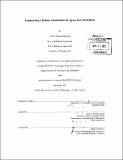| dc.contributor.advisor | Dava J. Newman. | en_US |
| dc.contributor.author | Meyen, Forrest Edward | en_US |
| dc.contributor.other | Massachusetts Institute of Technology. Department of Aeronautics and Astronautics. | en_US |
| dc.date.accessioned | 2014-03-19T15:46:56Z | |
| dc.date.available | 2014-03-19T15:46:56Z | |
| dc.date.copyright | 2013 | en_US |
| dc.date.issued | 2013 | en_US |
| dc.identifier.uri | http://hdl.handle.net/1721.1/85810 | |
| dc.description | Thesis: S.M., Massachusetts Institute of Technology, Department of Aeronautics and Astronautics, 2013. | en_US |
| dc.description | Cataloged from PDF version of thesis. | en_US |
| dc.description | Includes bibliographical references (pages 177-181). | en_US |
| dc.description.abstract | Novel methods for assessing space suit designs and human performance capabilities are needed as NASA prepares for manned missions beyond low Earth orbit. Current human performance tests and training are conducted in space suits that are heavy and expensive, characteristics that constrain possible testing environments and reduce suit availability to researchers. Space suit mock-ups used in planetary exploration simulations are light and relatively inexpensive but do not accurately simulate the joint stiffness inherent to space suits, a key factor impacting extravehicular activity performance. The MIT Man-Vehicle Laboratory and Aurora Flight Sciences designed and built an actively controlled exoskeleton for space suit simulation called the Extravehicular Activity Space Suit Simulator (EVA S3), which can be programmed to simulate the joint torques recorded from various space suits. The goal of this research is to create a simulator that is lighter and cheaper than a traditional space suit so that it can be used in a variety of testing and training environments. The EVA S3 employs pneumatic actuators to vary joint stiffness and a pre-programmed controller to allow the experimenter to apply torque profiles to mimic various space suit designs in the field. The focus of this thesis is the design, construction, integration, and testing of the hip joint and backpack for the EVA S3. The final designs of the other joints are also described. Results from robotic testing to validate the mechanical design and control system are discussed along with the planned improvements for the next iteration of the EVA S3. The fianl EVA S3 consists of a metal and composite exoskeleton frame with pneumatic actuators that control the resistance of motion in the ankle, knee, and hip joints, and an upper body brace that resists shoulder and elbow motions with passive spring elements. The EVA S3 is lighter (26 kg excluding the tethered components) and less expensive (under $600,000 including research, design, and personnel) than a modem space suit. Design adjustments and control system improvements are still needed to achieve a desired space suit torque simulation fidelity within 10% root-mean-square error. | en_US |
| dc.description.statementofresponsibility | by Forrest Edward Meyen. | en_US |
| dc.format.extent | 182 pages | en_US |
| dc.language.iso | eng | en_US |
| dc.publisher | Massachusetts Institute of Technology | en_US |
| dc.rights | M.I.T. theses are protected by copyright. They may be viewed from this source for any purpose, but reproduction or distribution in any format is prohibited without written permission. See provided URL for inquiries about permission. | en_US |
| dc.rights.uri | http://dspace.mit.edu/handle/1721.1/7582 | en_US |
| dc.subject | Aeronautics and Astronautics. | en_US |
| dc.title | Engineering a robotic exoskeleton for space suit simulation | en_US |
| dc.type | Thesis | en_US |
| dc.description.degree | S.M. | en_US |
| dc.contributor.department | Massachusetts Institute of Technology. Department of Aeronautics and Astronautics | |
| dc.identifier.oclc | 872119685 | en_US |
